
Verbascum, mullein: planting, growing and care
Contents
Verbascum in a nutshell
- Verbascum offers a bright, impressive flowering in summer
- It bears erect spikes of yellow, white, pink, mauve or orange flowers
- It is also valued for its downy, sometimes silvery foliage
- It provides plenty of structure and verticality in borders
- Sun-loving plant for poor, dry soil, perfect in rockeries or Mediterranean gardens, economical in water!
A word from our expert
Also called mullein or common mullein, Verbascum is a biennial or perennial plant that produces in summer long upright spikes made up of often yellow flowers. Verbascum also bears large leaves, sometimes with a superb silvery hue. They are downy, pubescent and very soft. Mullein flowers are usually yellow or white, but breeders have created numerous varieties in a range of colourful shades: pink, orange, purple, mauve… and even blue.
With its long upright flowering stems, mullein is an imposing, highly architectural plant that adds height and structure to beds. The largest varieties can reach 2 m tall, while dwarf varieties are also available, suitable for borders or to adorn the front of a bed.
Best known is Verbascum thapsus, the true common mullein. In addition to its ornamental appeal, it has medicinal properties. It is effective against respiratory tract ailments, coughs and sore throats; the flowers are mainly used, and can be taken as a herbal tea or made into a syrup.
Mullein is an undemanding plant and easy to grow. It suits dry, poor soils and thrives in full sun. It can fit into a Mediterranean-style garden, a rockery or a water-wise border. Verbascum thapsus may self-seed in the garden.
Description and botany
Botanical data
- Latin name Verbascum sp.
- Family Scrophulariaceae
- Common name mullein, common mullein, black mullein
- Flowering June to Augustu2013September
- Height between 30 cm and 2 m
- Exposure full sun
- Soil type well-drained, even dry and stony
- Hardiness -20 °C
Mulleins comprise nearly 360 species of biennials or perennials, often villous or pubescent. They occur mainly in Europe and Asia, but also in North Africa. Greatest species diversity is found in the Mediterranean region. In France, 13 species are found in the wild, including Verbascum thapsus. They grow notably on fallow land, in meadows, on rocky places and along track edges…
The best known is Verbascum thapsus, also called common mullein. It is a biennial: in first year it produces a rosette of leaves, then in second year a flowering stem. It then dies, but can self-seed. Sometimes Verbascum thapsus appears spontaneously in gardens, self-seeding like a very decorative weed that you may prefer to keep!
Common mullein, Verbascum thapsus, is a ruderal plant: a pioneer plant that establishes on disturbed, fallow or unstable ground. It is among the first plants to arrive when soil is still bare. Mullein self-seeds easily. Seeds and young seedlings need bare soil to develop, which is why it will not establish spontaneously where a true vegetative cover already exists.
Verbascum thapsus has many vernacular names: Cierge de Notre-Dame, Bouillon-blanc, Herbe de Saint-Fiacre, mollein… In the past, flowering stems of Verbascum thapsus were used as torches after being dipped in resin, tallow or wax, hence the name Cierge de Notre-Dame. Etymologically, Verbascum may be a deformation of Latin Barbascum: “bearded”, referring to stamens bearing filaments covered with hairs. Species name thapsus comes from Thapsos, an ancient town in Sicily. Name molène may derive from mol: “soft”, in reference to the plant’s foliage.
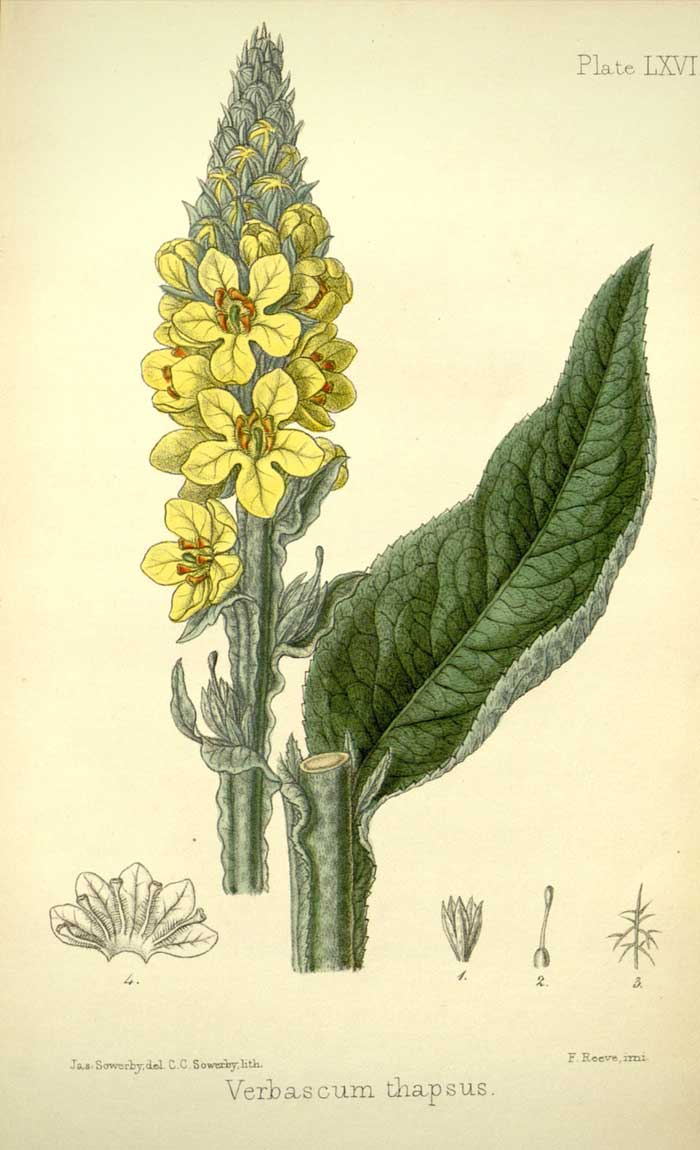
Verbascum thapsus: botanical illustration
Mullein belongs to family Scrophulariaceae (nearly 1,600 species). This family includes notably Buddleias (butterfly bushes), Nemesias and Diascias, plants sometimes grown in gardens for their abundant, colourful flowering.
Verbascum have an erect, very upright habit. They range from 30 cm for the smallest to 2 m tall for the tallest (notably Verbascum thapsus). There are attractive dwarf varieties, such as ‘Sugar Plum’, well suited to planting at the front of a border, at an edge or in a large pot to enhance, for example, a terrace.
Mullein begins by forming a rosette of leaves at ground level, then sends up a tall flowering stem. This stem is robust and thick, giving the plant a rather rigid aspect. In biennials, such as Verbascum thapsus, the leaf rosette forms in the first year and the flowering stem appears in the second year. It is winter cold that enables the plant to flower the following year! The plant will disappear afterwards, having dispersed its seeds.
Around June, the plant produces one or more flowering stems from the centre of the leaf rosette. Common mullein, Verbascum thapsus, usually produces a single stem. There are very different species too, such as Verbascum acaule, which lacks a flowering stem! Its flowers appear at the level of the leaf rosette.
Mullein flowers throughout summer, generally from June to August–September. Flowering is long, up to three months. Flowers open progressively, one after another, usually from base of the stem towards the top. Often only a few flowers are open at once on a stem. Each flower is fairly short-lived, generally lasting only a day on Verbascum thapsus… But there are so many flowers on a spike that they succeed one another continuously, allowing prolonged flowering!
Mullein bears long, dense spikes or clusters made of very large numbers of flowers. These can reach up to a metre long and are more or less ramified. They are little ramified in Verbascum thapsus, but very ramified in Verbascum olympicum… giving the plant a truly different silhouette!
Flowers are fairly regular in shape, with radial symmetry… rather rare for a plant in family Scrophulariaceae! They are cup-shaped, wide open. Flowers usually measure 2 to 4 cm across and have five very rounded petals. Petals are fused at the base into a very short tube and surrounded by five sepals. At centre are five stamens, quite decorative. Sometimes these bear long coloured hairs on their filaments, as in Verbascum nigrum!
Flowers are most often yellow or white… but many horticultural varieties have been developed, now offering blooms in varied colours: pink, mauve, purple, orange, coppery, even red… There is even a blue-flowered Verbascum: ‘Blue Lagoon’! Its flowering recalls, in a way, delphinium spikes. In Verbascum thapsus, flowers are yellow and stamens orange.
Mullein flowers can show superb shading, usually darker in centre. They are very contrasting in mullein ‘Cotswold Queen’! Likewise, in centre of flower stamens often display beautiful orange or violet hues. Flowers of Verbascum nigrum bear violet–purple stamens!
Mullein is an excellent melliferous plant. Many insects, including bees and hoverflies, visit the flowers. Plant mullein to compose a border favourable to insects and to biodiversity!
Withered inflorescences persist long on the plant. They remain in place through winter. For aesthetic reasons, you may cut them.

Mulleins come in a lovely range of colours! From left to right: Verbascum ‘Clementine’, Verbascum ‘Cotswold Queen’, Verbascum nigrum ‘Album’ and Verbascum phoeniceum (photo Geaster)
Mullein has a very elegant outline, with large leaves spread all around the stump, and a tall, vertical flower spike.
Mullein forms a broad rosette of leaves at ground level, reaching up to 60 cm wide! Rosette of Verbascum thapsus remains through winter. Plant is therefore decorative all year round. Basal leaves measure between 30 and 50 cm long, while those of garden varieties are generally smaller.
Mullein also carries cauline leaves, placed alternately on the stem, smaller than basal leaves. Generally, the higher up the stem, the smaller the leaves.
Beyond flowering, mullein is valued for its downy, pubescent foliage. Leaves are simple, entire, ovate. They are thick yet remain supple. They are covered with a white felt, giving a velvety texture, very soft. Hairs on leaves give plant a more or less silvery tone… Species Verbascum bombyciferum is remarkable for its superb grey colour!

Downy foliage of Verbascum thapsus and of Verbascum phlomoides
Mullein has a taproot, anchoring it firmly and enabling the plant to access water deep down, making it quite drought tolerant.
Mullein fruit is a capsule that opens by two valves when ripe. Each plant produces many capsules, each containing hundreds of tiny seeds. Thus a single plant can easily produce more than 100,000 seeds! Moreover, these remain viable for several decades, retaining their seed viability.
Verbascum thapsus tends to self-seed if you leave withered flowering stems in place. Seeds germinate on bare soil, in an unoccupied spot. They do not travel far: if new seedlings appear, they will probably be near the parent plant.

Capsules (photo Didier Descouens – Museum of Toulouse) and seeds of Verbascum blattaria
Main varieties of Verbascum
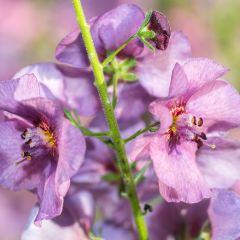
Verbascum Pink Domino - Mullein
- Flowering time July to September
- Height at maturity 1 m
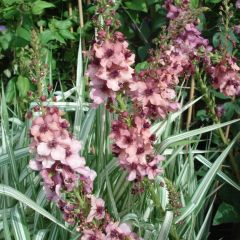
Verbascum Southern Charm - Mullein
- Flowering time July to September
- Height at maturity 70 cm
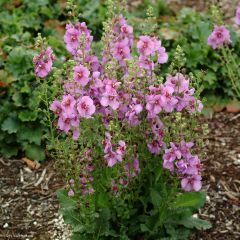
Verbascum Sugar Plum - Mullein
- Flowering time June to September
- Height at maturity 40 cm
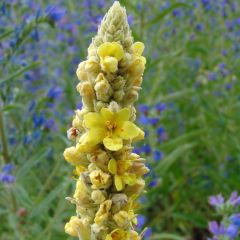
Verbascum thapsus - Mullein
- Flowering time July to September
- Height at maturity 1,75 m
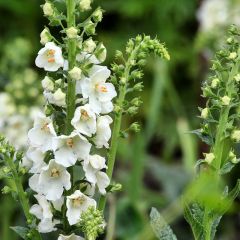
Verbascum phoeniceum Flush of White - Mullein
- Flowering time July, August
- Height at maturity 80 cm
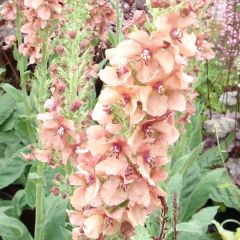
Verbascum Jackie - Mullein
- Flowering time July to October
- Height at maturity 35 cm
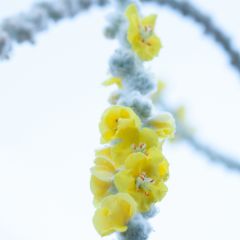
Verbascum bombyciferum Polarsommer - Mullein
- Flowering time August to October
- Height at maturity 1,60 m
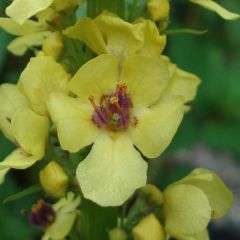
Verbascum Cotswold Queen - Mullein
- Flowering time July to September
- Height at maturity 1,50 m
Discover other Verbascum - Mullein
View all →Available in 1 sizes
Available in 1 sizes
Available in 1 sizes
Available in 0 sizes
Available in 0 sizes
Available in 1 sizes
Available in 1 sizes
Available in 1 sizes
Available in 1 sizes
Available in 1 sizes
Planting Verbascum
Where to plant?
We recommend planting mullein in full sun. This exposure is most favourable, ensuring abundant flowering. Some varieties also grow well in partial shade, provided light levels are fairly high.
Overall, mullein is an undemanding plant, but it is essential that soil is well drained. It dislikes soils that retain water, particularly heavy, compact soils… Avoid if ground is especially clayey! (unless planting in a container or seriously improving drainage). It also likes calcareous, alkaline soils.
As mullein appreciates dry, poor, stony ground, you can easily place it in a rockery. It is also ideal for planting on banks.
Mullein is quite tall when in flower, which is why it is better to place it at back of borders, behind lower plants. It will bring structure and verticality. However, some dwarf varieties, such as ‘Sugar Plum’, can be placed on a border, at front of a bed, or in a pot or container.
Being an easy plant that needs little and tolerates stony or sandy soil, you can use it to green a difficult area. It is ideal for filling space (as it is very large), even on poor soil!
When to plant?
Best to plant mullein in spring, around April, although planting can also be done in autumn.
How to plant?
Mulleins form large rosettes of leaves: we suggest spacing the smallest varieties about 40 cm apart, but leave at least 70 – 80 cm between the largest. Avoid planting too densely!
- Dig a planting hole. Feel free to add draining materials, such as gravel or coarse sand… You can also plant on a mound to help water run off.
- Remove rootball from its pot and plant your Verbascum. The collar should be at soil level, or slightly above (to prevent water pooling at the collar).
- Replace soil around plant, and firm down.
- Water generously.
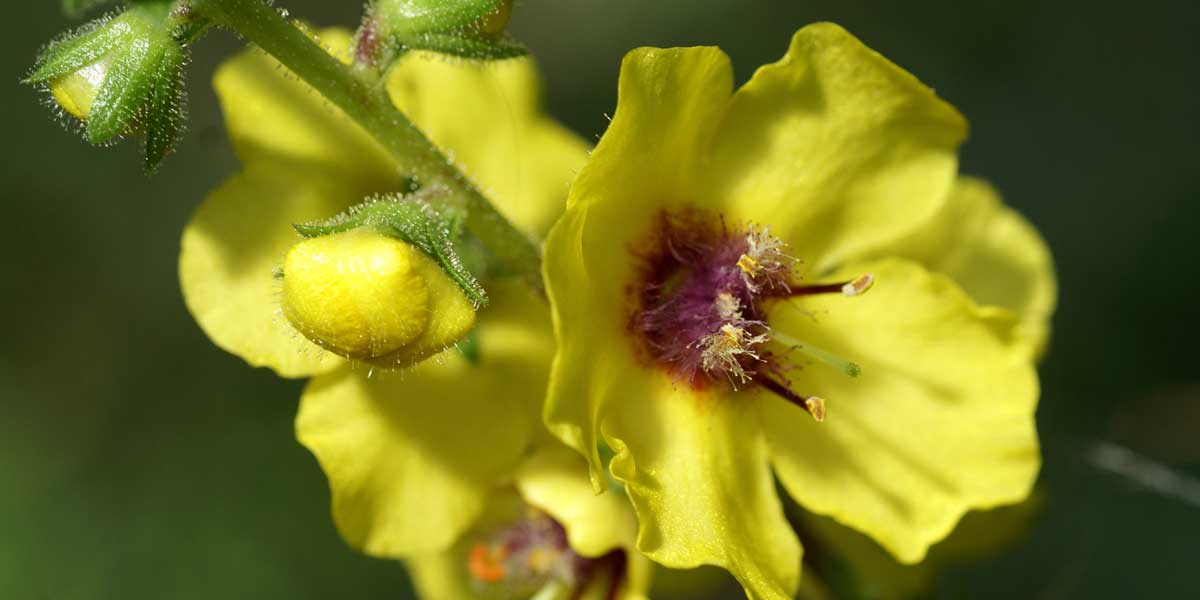
Care
Mullein requires very little maintenance. It tolerates drought well, even in summer. It generally needs no watering and also requires no fertiliser.
We suggest applying a layer of mulch at the base of your mulleins. This will slow the growth of weeds.
Because they have thick, rigid stems, mullein usually does not require staking, except when planted in particularly fertile soil or exposed to strong winds.
Cut flower spikes once they have faded. You can leave a few in place if you want the plant to self‑seed.
Mullein is a hardy plant, not very susceptible to diseases and pests. It can occasionally be affected by powdery mildew, a fungal disease marked by white spots on the leaves. If you notice it, we recommend removing affected parts and treating with a sulphur‑based solution. Leaves may also be eaten by caterpillars, notably the mullein moth (Cucullia verbasci).
Propagation
Best technique to propagate mullein is sowing. It sometimes self-sows if spent flower stems are left in place.
Sowing
You can sow Verbascum seeds in spring, in April or May. Horticultural varieties may, however, produce flowers somewhat different from original variety. By contrast, Verbascum seeds store very well: they remain viable for decades.
Mullein has tiny seeds: we recommend mixing them with sand to make handling easier. As they need light to germinate, do not cover them with substrate afterwards.
- Prepare a seed tray or small tray by filling it with potting compost (to which you can add some sand to improve drainage). Water so substrate is evenly moist.
- Mix seeds with sand to distribute them more easily over potting compost.
- Scatter them on surface, but do not cover them!
- You can firm down gently.
- Place tray under a cold frame.
Substrate must remain slightly moist until germination, which will occur after one or two weeks. You can plant out after last frosts, or in early autumn.
As Verbascum thapsus is a biennial, it will produce a rosette of leaves in first year, then flower in following year. Some varieties (such as ‘Southern Charm’) may flower in first year.
You can also sow mullein in autumn and prick out in spring.
Finally, it is possible to sow Verbascum directly in open ground, but if rosette of leaves that forms is still small when winter arrives, it may die from cold. If it has had time to develop well, it will survive.
Companion planting with mulleins in the garden
Mulleins are perfect for integrating into a dry, stony garden. You can pair them with other plants that tolerate drought and accept poor, gravelly soil… Plant them with achilleas, Eryngium, teasels (Dipsacus fullonum), euphorbias… Add some clumps of grasses, such as Stipa tenuifolia. They can also be combined with Mediterranean plants, such as Jerusalem sages (Phlomis fruticosa), lavender, rosemary, grasses, Euphorbia characias…
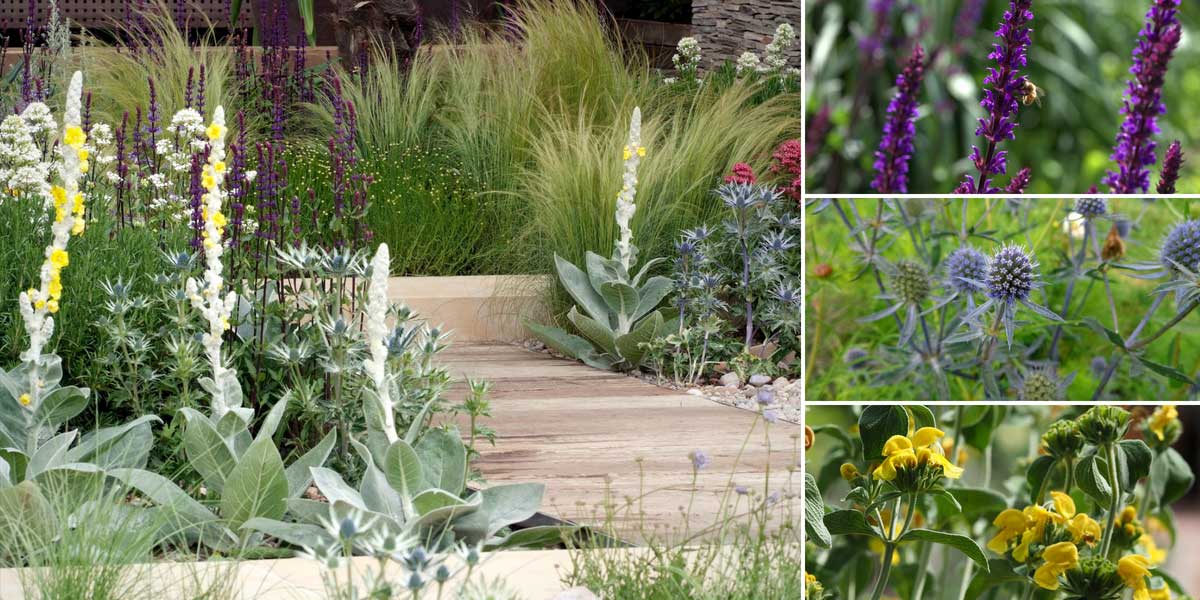
Verbascums can fit into a dry, mineral garden. A scene with Verbascum ‘Polarsommer’, Eryngium oliverianum, Centranthus ruber, Salvia caradonna and Stipa tenuifolia (photo AC – Nathalie Pasquel – MAP – Landscape gardener Robert Myers) / Salvia nemorosa ‘Caradonna’ / Eryngium planum / Phlomis fruticosa
Mulleins combine very well with other plants with silky, downy foliage, such as Stachys byzantina, Salvia argentea or Phlomis lanata… Also discover Centaurea ragusina, a knapweed with superb silvery foliage and yellow flowers! To reinforce this silky, soft effect, make use of flower spikes of grasses, such as Stipa pennata or Pennisetum… Also plant some wormwoods, such as Artemisia ‘Powis Castle’. You will obtain a border that plays with rays of sunlight, creating highlights on foliage of perennials and spikes of grasses!
Verbascums that flower in pink or apricot can be incorporated into a romantic or cottage garden. They help create a vintage style. Do try variety ‘Southern Charm’, and pair it with traditional roses, Oriental poppies, nepeta and gypsophilas… Favour pastel shades and soft, warm tones: orange, purple, pink, soft yellow… You can also plant them alongside mauve flower spikes of Phlomis tuberosa ‘Amazone’
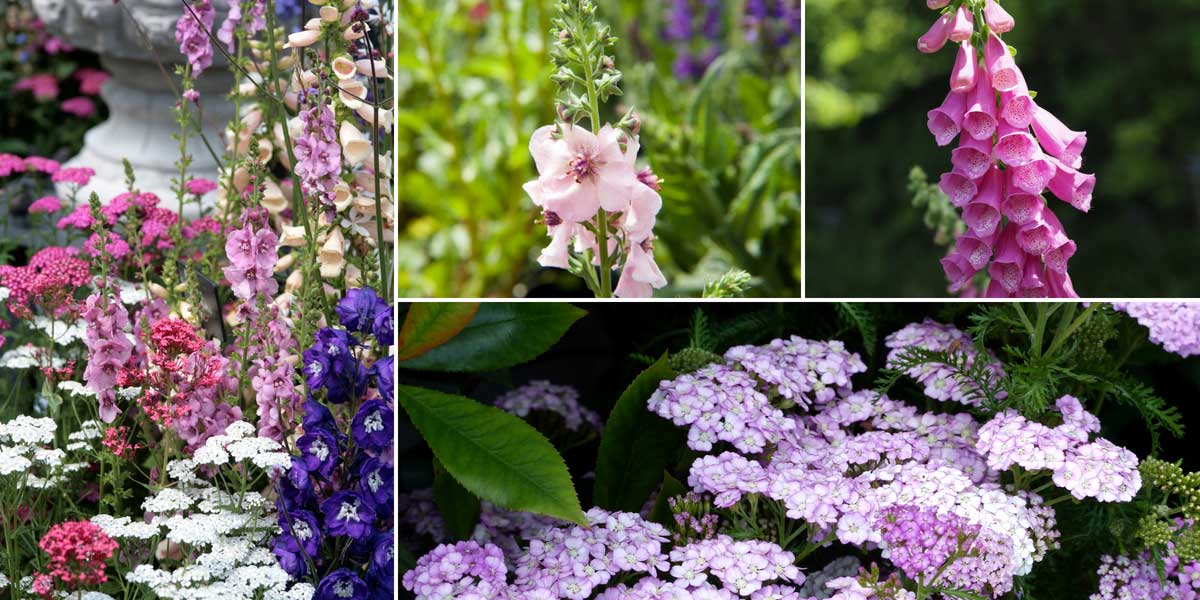
Mulleins can also be incorporated into a romantic-style garden! An association with Verbascum ‘Rosie’, delphinium and achilleas / Verbascum ‘Jackie in Pink’ (photo David J. Stang) / Digitalis purpurea / Achillea ‘Apple Blossom’
Mulleins can be integrated into a colourful mixed border, alongside rudbeckias, echinaceas, achilleas, roses and alchemillas. You’ll achieve a lovely visual effect by installing some other plants with upright flower stems to echo the verbascums: foxgloves, delphiniums…
With its many properties, Verbascum thapsus can easily be incorporated into a medicinal plant garden. Finally, you can also plant mullein in the vegetable garden, because it attracts a bug (Campylomma verbasci) that eats aphids… So it’s a good companion plant for combating them.
Did you know?
- Medicinal plant
Verbascum thapsus is an effective plant against sore throat, cough and inflammations of the breathing system. It is a soothing, emollient, mucilaginous plant. It can be consumed as a decoction or infusion, after being carefully filtered (to remove hairs that can be irritating). Cough syrup can be made using the flowers.
Useful resources
- Discover our range of mulleins!
- Discover 6 ideas for successful combinations with Verbascum
- An interesting article on mulleins
- Discover other cuddly plants in our guide
Frequently asked questions
-
Leaves on my Verbascum have white spots. Why?
It is probably affected by powdery mildew, a fungal disease. As soon as you notice first symptoms, remove damaged leaves and treat by spraying a sulphur-based solution or a horsetail decoction. You can also prune nearby plants to improve air circulation. Avoid watering foliage, as moisture favours this fungal disease.
-
Leaves look nibbled
The culprit is probably a caterpillar, the mullein moth, which is feasting on mullein foliage. Inspect the leaves to find the caterpillars, and if you spot any, the only solution is to remove them by hand.
-
My Verbascum is not flowering... Why?
Verbascum thapsus is a biennial: it produces a rosette of leaves in its first year, and flowering occurs only in the second year. So you need to wait a little to enjoy the flowering! However, there are also varieties that flower in their first year.
- Subscribe!
- Contents
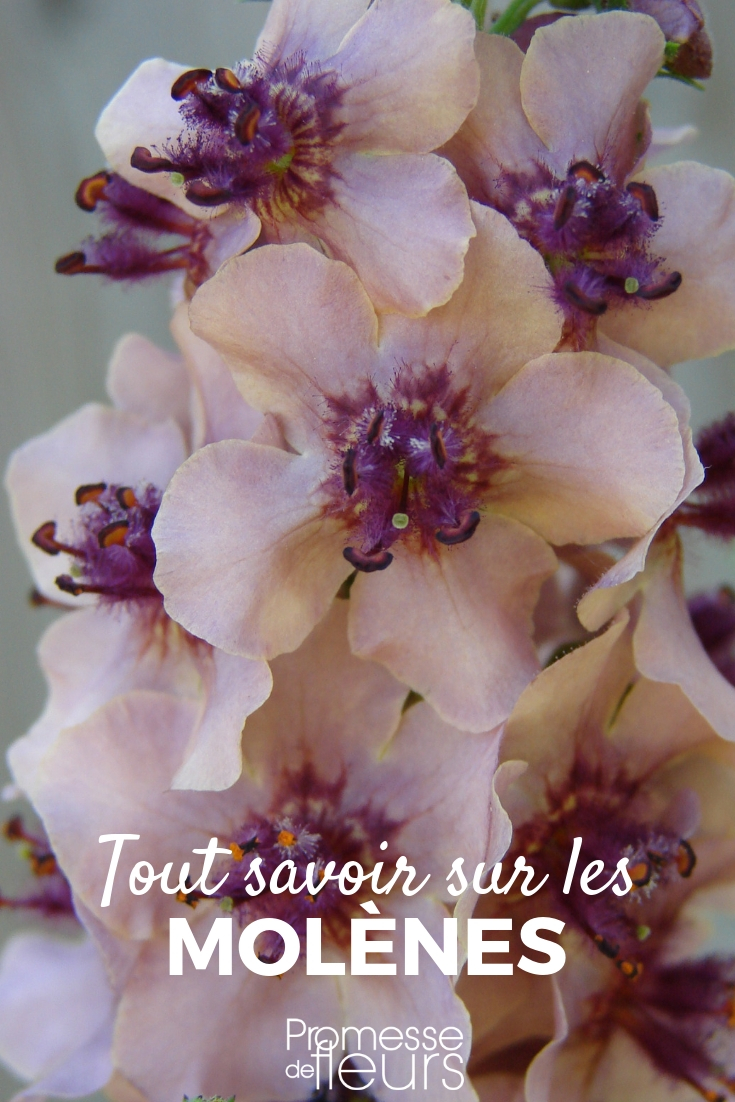































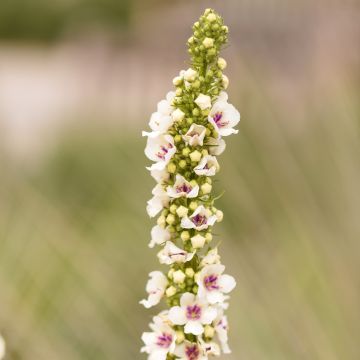

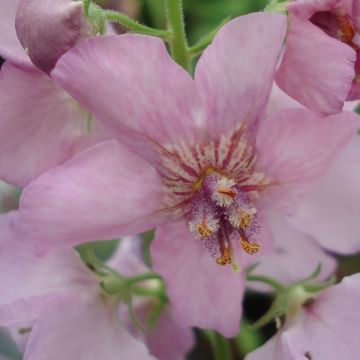






Comments